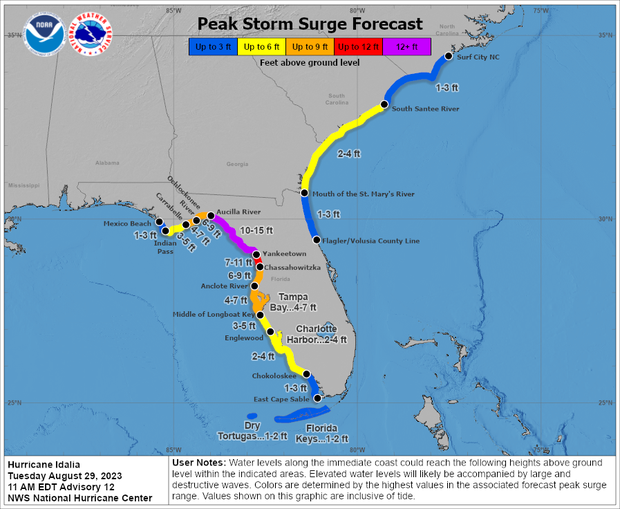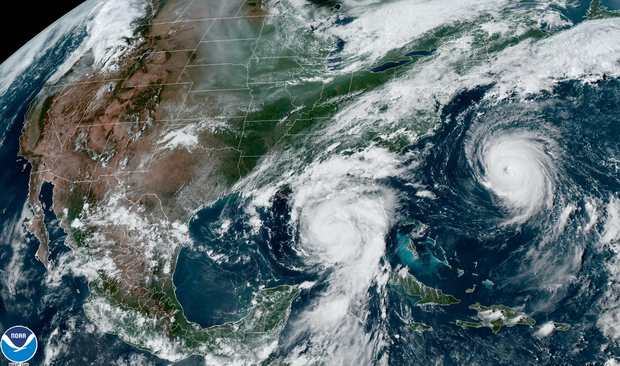Idalia strengthened into a Category 2 hurricane Tuesday afternoon and is forecast to intensify quickly into an extremely dangerous major hurricane before making landfall over Florida’s Gulf Coast Wednesday, the National Hurricane Center says.
Its path is expected to impact a wide central portion of the state, including cities such as Tampa and Orlando, before moving along the Georgia and Carolina coastline Wednesday into Thursday.
You can see a live feed of Hurricane Idalia radar tracking in the video below:
When is Hurricane Idalia expected to make landfall?
Idalia is expected to make landfall along the Gulf Coast of Florida on Wednesday, likely centered in the Big Bend area, with hurricane conditions extending along the coast.
“We do expect Hurricane Idalia to be a major hurricane that will strike the state of Florida,” Gov. Ron DeSantis said at a briefing, warning that residents living across Florida’s Gulf Coast should prepare for “major impacts” from the oncoming storm.
At a briefing Tuesday evening, DeSantis urged people to leave immediately if they were in an evacuation zone.
“If you stay hunkered down tonight, it’s going to be too nasty tomorrow morning to be able to do it,” he said.
“If you do choose to stay in one of the evacuation zones, first responders will not be able to get you until after the storm has passed.”
Hurricane Idalia’s location and warnings
Idalia was moving towards the Florida coast from the Gulf of Mexico on Tuesday. As the storm intensified, meteorologists warned that Idalia was expected to bring “life-threatening storm surge and hurricane conditions” to parts of the Gulf coast by Tuesday night, continuing into Wednesday.
As of 5 p.m. ET., Idalia was located approximately 195 miles southwest of Tampa and 300 miles south of Tallahassee. The storm was moving north at 16 mph, and had maximum sustained winds of 100 miles per hour, according to the National Hurricane Center.
A storm must have maximum sustained winds of at least 74 mph for it to be classified as a hurricane. Once wind speeds reach 96 mph, the hurricane becomes a Category 2.
NOAA / National Weather Service
Idalia’s squalls had spread to parts of the lower Florida Keys and the southwestern coast of mainland Florida early Tuesday afternoon. Footage shared on Facebook by the City of Key West showed flooding on the island, with water inundated some streets up to the curb, from the hurricane’s outer bands just before noon, at high tide.
DeSantis said Idalia was expected to hit Florida on Wednesday morning along the state’s Big Bend area as a major hurricane. Projections indicated the storm would grow into at least a Category 3 hurricane before making landfall.
“If this storm hits at high tide, storm surge could reach 8 to 12 feet in some areas, so that would be a life-threatening storm surge,” DeSantis said.
CBS News senior weather and climate producer David Parkinson noted Tuesday that current estimates suggest the storm could arrive on Wednesday between 7 a.m. and 11 a.m. ET. He said the massive storm surge expected to accompany Idalia’s arrival on land “is the primary threat with this storm.”
“There is likely a level of people being caught off guard farther south as the storm is just skirting by,” he said. “The storm surge may go as far as US19 inland, so there’s a lot of area covered by that, even if the coast isn’t populated like near Naples. No one alive in these areas has seen flooding this bad there if it hits max potential.”
Forecasters have put communities under a range of severe weather advisories, from hurricane and tropical storm warnings and watches to storm surge warnings and watches.
DeSantis declared a state of emergency in 49 counties and the state mobilized more than 5,500 National Guard members to respond to the storm. Between 30,000 and 40,000 electricity workers would be on hand to restore power after the storm hits, the governor said.
Evacuation orders or recommendations were posted in 28 counties and dozens of school districts across Florida had suspended classes.
Meanwhile, Hurricane Franklin, to the east over the Atlantic, was churning on a track that’s expected to remain off the East Coast.
It was a major Category 4 hurricane early Tuesday packing 140 mph sustained winds and bringing “life-threatening surf and rip currents” along the southeastern U.S. coastline that were expected to “spread northward,” the hurricane center said. Franklin “is expected to pass well to the northwest of Bermuda on Wednesday,” the center added, and is expected to weaken starting Tuesday afternoon.
Meteorologists rate hurricanes according to the Saffir-Simpson Wind Scale, categorizing storms that fall within Categories 3, 4 or 5 as “major” hurricanes capable of causing “significant loss of life and damage,” according to the National Hurricane Center. The categories are based on a hurricane’s maximum sustained wind speeds.
Where is Hurricane Idalia going to hit?
Florida’s Gulf Coast is in Idalia’s sights, putting communities at risk in central parts of the state and up through the panhandle.
The National Hurricane Center has issued hurricane warnings for much of the state’s west coast, from Sarasota County through Franklin County in the panhandle. Hurricane warnings were updated Tuesday to include Tampa Bay. Storm surge watches are also in effect for those areas.
At his news conference Tuesday morning, the governor noted that meteorologists “have nudged the track a little bit further west over the last 24 hours,” placing the potential target area for Idalia’s landfall closer to, or directly over, Florida’s capital city, Tallahassee, where the briefing was held.
“We were looking at potentially Levy County, I think, yesterday. Today, now, we’re looking more at Taylor County,” DeSantis said. Levy County encompasses the coastal region just west of Gainesville, while Taylor County sits about 90 miles up the coast toward Tallahassee.
“There are some models that say it could go even further west, so places like Tallahassee … certainly, you could end up having it hit Tallahassee directly and some of the surrounding area,” he continued. “So everyone just remain vigilant, continue to watch, and listen to the local orders that you receive from your local emergency management personnel.”
With hurricane preparations underway, DeSantis urged people living in low-lying coastal areas along the Gulf, many of whom are under evacuation notices ahead of Idalia’s anticipated arrival, to move to higher ground until the storm passes.
“You run from the water and you hide from the wind. If you’re there in that storm surge, you’re putting your life in jeopardy when it gets to be that high,” the governor said.
NOAA/National Weather Service
A major hurricane has never entered the Apalachee Bay, located just south of Tallahassee where the Florida peninsula meets the mainland U.S., said the city’s National Weather Service branch, which called the potential arrival of Idalia “unprecedented” and warned that hurricane “preparations need to be rushed to completion by sunset” on Tuesday.
Conditions were expected to “rapidly deteriorate” after that, the weather service said.
“Hurricane Idalia will likely be an unprecedented event for many locations in the Florida Big Bend. Looking back through recorded history, NO major hurricanes have ever moved through the Apalachee Bay. When you try to compare this storm to others, DON’T. No one has seen this,” reads a message posed to the front page of the website for NWS Tallahassee.
As Idalia intensified Tuesday, DeSantis told Florida residents: “There’s a huge number of counties that are going to feel impacts from this.” He referenced updated computer models from the National Hurricane Center that indicated the storm could impact inland areas as well, including Columbia County and Madison County, which sit near Florida’s border with Georgia, between Tallahassee and Jacksonville.
Earlier, the National Weather Service warned, “The risk continues to increase for life-threatening storm surge and dangerous hurricane-force winds along portions of the west coast of Florida and the Florida Panhandle beginning as early as late Tuesday.”
As the agency noted, storm surge watches and hurricane watches were in effect for large portions of the Gulf Coast of Florida.
Storm surge could reach up to 12 feet or 15 feet for much of northwestern Florida and into the panhandle, meteorologists warned, while coastal areas as far south as Cape Sable, in the Everglades, and the Florida Keys could see storm surges of up to 2 or 3 feet above ground level.
Storm surge is a rise in water levels caused by hurricane-force winds that push water toward shore and over areas of land that are normally dry, according to the National Oceanic and Atmospheric Administration. This phenomenon is considered the greatest threat to life during a hurricane.
Forecasters also warned that “areas of flash and urban flooding, some of which may be locally significant, are expected across portions of the west coast of Florida, the Florida Panhandle, and southern Georgia Tuesday into Wednesday, spreading into portions of the eastern Carolinas Wednesday into Thursday.”
Tropical storm warnings were issued for areas stretching from the Altamaha Sound in Georgia to the South Santee River in South Carolina as of 11 a.m. on Tuesday. A tropical storm watch was in effect for much of the Carolina coast, from the South Santee River up to Surf City in North Carolina.
A hurricane warning means that hurricane conditions are expected somewhere within the boundaries of the warning area, while a hurricane watch means those conditions are possible, according to the National Hurricane Center. Forecasters are urging people in areas under hurricane warnings to prepare for the onset of conditions within the next 12 to 24 hours. People living in areas placed under storm surge watches should prepare for the “possibility of life-threatening inundation, from rising water moving inland from the coastline” over the next 48 hours, the hurricane center said.
There is a possibility of strong and potentially damaging wind gusts from Idalia that could “extend well eastward from the storm’s center” once it makes landfall in Florida, the weather service said. Meteorologists added that torrential downpours could also happen in eastern parts of the state, which may be subject to increasing tornado threats as well.
The National Hurricane Center said “a few tornadoes will be possible” along the west-central Florida coast throughout Tuesday, with the tornado threat spreading to the state’s Big Bend area by Tuesday night and toward southeastern Georgia and the Carolinas on Wednesday.
Idalia is likely to remain at hurricane strength as it moves across southern Georgia, and possibly when it reaches the coast of Georgia or southern South Carolina later on Wednesday, the National Hurricane Center said.
Map of Hurricane Idalia’s projected path
Meteorologists are forecasting a northeastern path for Idalia as it intensifies, tracking over the Gulf of Mexico toward the northwest coast of Florida throughout Tuesday and into Wednesday.
After making landfall along Florida’s Gulf Coast, Idalia is expected to continue across northern Florida and coastal Georgia and the Carolinas on Wednesday and Thursday, decreasing in strength as it travels.
NOAA / National Weather Service
Will Idalia and Franklin hit Florida at the same time?
Hurricane Franklin is not expected to hit Florida, but it will cause rough surf conditions and rip currents. Officials haven’t issued any forecasts suggesting that Franklin will make landfall anywhere along the East Coast.
NOAA
As Idalia approaches, the National Weather Service has issued tropical storm watches and warnings for parts of eastern central Florida, including Orlando, where residents have been urged to prepare for “local tropical storm conditions by Tuesday night and into Wednesday.
An incoming “long-period swell” in the Atlantic caused by Hurricane Franklin will make the coast susceptible to “high seas, rough surf, an increase in life-threatening rip currents, and beach erosion during high tides during Tuesday and Wednesday,” according to the hurricane center.





